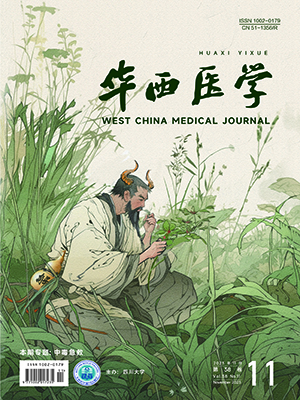【摘要】 目的 探討腹水引起的腹內高壓對肝硬化小鼠肺組織水通道蛋白1(AQP1)和水通道蛋白5(AQP5)表達的影響。 方法 雄性美國癌癥研究所(Institudo of Cancer Reseach,ICR)小鼠50只,隨機取10只作正常對照組(腹壓0 cm H2O,1 cm H2O=0.098 kPa),其余40只用四氯化碳建立肝硬化小鼠模型,并隨機分為4組:肝硬化(腹壓0 cm H2O)組、肝硬化(腹壓5 cm H2O)組、肝硬化(腹壓10 cm H2O)組、肝硬化(腹壓20 cm H2O)組,通過腹腔注射不同量的白蛋白生理鹽水形成不同的腹壓,并維持腹壓24 h后取肺組織行病理、免疫組織化學、肺濕/干比值及實時熒光定量PCR檢測AQP1和AQP5 mRNA表達量。 結果 與正常對照小鼠相比,肝硬化小鼠肺AQP5、AQP1表達明顯下降(P lt;0.05);肝硬化小鼠隨著腹內壓的升高,肺濕/干比值升高,AQP5、AQP1表達相應增加(P lt;0.05)。 結論 肝硬化可以影響肺AQP1、AQP5的表達;肝硬化小鼠隨著腹內壓的升高,AQP1、AQP5表達相應增加,并與肺水腫的嚴重程度密切相關。
【Abstract】 Objective To investigate the role of intra-abdominal hypertension caused by ascites on the expression of Aquaporin (AQP) 1 and AQP 5 in the lung of cirrhotic mice. Methods We randomly chose 10 from 50 male Institude of Cancer Research (ICR) mice to form the control group [intra-abdominal pressure (IAP)=0 cm H2O, 1 cm H2O=0.098 kPa]. The model of cirrhosis were prepared by subcutaneous injection of carbon tetrachloride for the rest 40 mice which were then randomly divided into 4 groups: cirrhosis (IAP=0 cm H2O) group, cirrhosis (IAP=5 cm H2O) group, cirrhosis (IAP=10 cm H2O) group, and cirrhosis (IAP=20 cm H2O) group. Saline with different volume of albumin was injected into the peritoneum of each mouse in order to form different IAP. After 24 hours, analysis of pathology, immunochemistry and wet/dry ratio was done for the lungs of these mice; and the expression of AQP1 and AQP5 at the protein and mRNA levels were analyzed by IHC and qRT-PCR. Results Compared with the normal mice, the expression of AQP1 and AQP5 in lungs of cirrhotic mice were significantly lower (P lt;0.05). Both the lung wet/dry ratio and the expression of AQP1 and AQP5 raised with the increase of IAP. Conclusion Cirrhosis can affect the expression of AQP1 and AQP5 in lungs. The expression of AQP5 and AQP1 in lungs of cirrhotic mice increases with the increase of IAP, which is also closely correlated with the severity of pulmonary edema.
引用本文: 張照杰,楊長青. 腹內高壓對肝硬化小鼠肺水通道蛋白1及水通道蛋白5表達的影響. 華西醫學, 2011, 26(2): 165-169. doi: 復制




